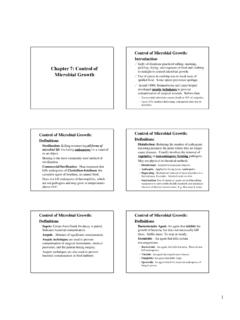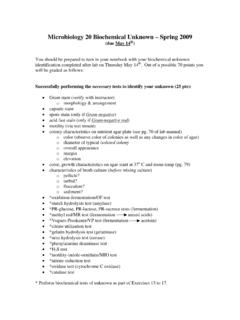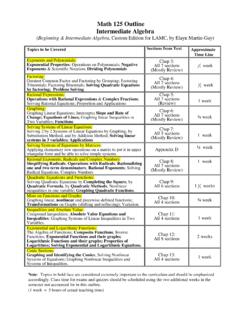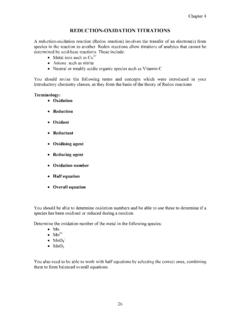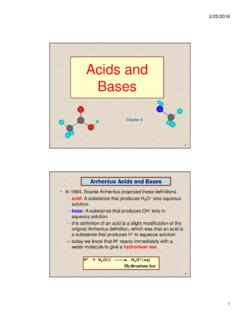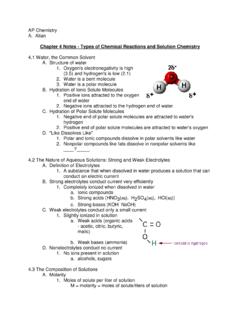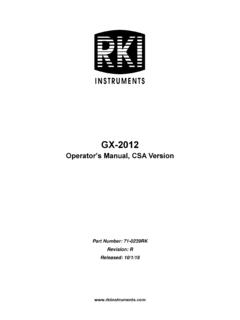Transcription of Microbial Growth: cell number Chapter 6: Microbial …
1 Microbial growth : 4 Refers to an increase in cell number , not in cell size. Chapter 6: Microbial growth 4 Bacteria grow and divide by binary fission, a rapid and relatively simple process. Requirements for growth Requirements for growth Physical Requirements Physical Requirements 1. Temperature: Microbes are loosely 1. Temperature: classified into several groups based on their B. Mesophiles: Middle loving . Most bacteria. preferred temperature ranges. u Include most pathogens and common spoilage A. Psychrophiles: Cold-loving . Can grow at organisms. 0 o C. Two groups: u Best growth between 25 to 40 oC.
2 U Optimum temperature commonly 37oC. u True Psychrophiles: Sensitive to temperatures over 20 oC. Optimum growth at 15oC or below. Found in u Many have adapted to live in the bodies of animals. very cold environments (North pole, ocean depths). Seldom cause disease or food spoilage. u Psychrotrophs : Optimum growth at 20 to 30 oC. Responsible for most low temperature food spoilage. Requirements for growth growth Rates of Bacterial Groups Physical Requirements at Different Temperatures 1. Temperature: C . Thermophiles: Heat loving . u Optimum growth between 50 to 60 oC.
3 U Many cannot grow below 45 oC. u Adapted to live in sunlit soil, compost piles, and hot springs. u Some thermophiles form extremely heat resistant endospores. u Extreme Thermophiles (Hyperthermophiles): Optimum growth at 80oC or higher. Archaebacteria. Most live in volcanic and ocean vents. 1. Requirements for growth Food Spoilage Temperatures Physical Requirements 2. pH: 4 Most bacteria prefer neutral pH ( ). 4 Molds and yeast grow in wider pH range, but prefer pH between 5 and 6. 4 Acidity inhibits most Microbial growth and is used frequently for food preservation ( : pickling).
4 4 Alkalinity inhibits Microbial growth , but not commonly used for food preservation. 4 Acidic products of bacterial metabolism interfere with growth . Buffers can be used to stabilize pH. Requirements for growth Requirements for growth Physical Requirements Physical Requirements 2. pH: Organisms can be classified as: 3. Osmotic Pressure : Cells are 80 to 90% water. A. Acidophiles: Acid loving . A. Hypertonicsolutions: High osmotic pressure u Grow at very low pH ( to ) removes water from cell, causing shrinkage of cell u Lactobacillus produces lactic acid, tolerates mild acidity.
5 Membrane (plasmolysis). B. Neutrophiles: Used to control spoilage and Microbial growth . u Grow at pH to u Sugar in jelly. u Includes most human pathogens. u Salt on meat. C. Alkaliphiles: Alkali loving . B. Hypotonic solutions: Low osmotic pressure causes u Grow at alkaline or high pH (7 to 12 or higher) water to enter the cell. In most cases cell wall u Vibrio cholerae and Alkaligenes faecalis optimal pH 9. prevents excessive entry of water. Microbe may u Soil bacterium Agrobacterium grows at pH 12. lyse or burst if cell wall is weak. Isotonic Versus Hypertonic Solution Effects of Osmosis on Bacterial Cells Plasmolysis 2.
6 Requirements for growth Requirements for growth Physical Requirements Chemical Requirements 3. Osmotic Pressure : 1. Carbon: Makes up 50% of dry weight of cell. u Halophiles: Require moderate to large salt u Structural backbone of all organic compounds. concentrations. Ocean water contains salt. u Chemoheterotrophs : Obtain carbon from their energy u Most bacteria in oceans. source: lipids, proteins, and carbohydrates. u Extreme or Obligate Halophiles: Require very u Chemoautotrophs and Photoautotrophs : Obtain carbon from carbon dioxide. high salt concentrations (20 to 30%).
7 U Bacteria in Dead Sea, brine vats. u Facultative Halophiles: Do not require high salt concentrations for growth , but tolerate 2% salt or more. Requirements for growth Requirements for growth Chemical Requirements Chemical Requirements 2. Nitrogen, Sulfur, and Phosphorus: . 2. Nitrogen, Sulfur, and Phosphorus: . A. Nitrogen: Makes up 14% of dry cell weight. Used to B. Sulfur: Used to form proteins and some vitamins form amino acids, DNA, and RNA. (thiamin and biotin). Sources of nitrogen: Sources of sulfur: u Protein: Most bacteria u Protein: Most bacteria u Ammonium : Found in organic matter u Hydrogen sulfide u Nitrogen gas (N 2): Obtain N directly from atmosphere.
8 U Sulfates: Salts that dissociate to give SO 42-. Important nitrogen fixing bacteria, live free in soil or C. Phosphorus : Used to form DNA, RNA, ATP, and associated with legumes (peas, beans, alfalfa, clover, etc.). Legume cultivation is used to fertilize soil naturally. phospholipids . u Nitrates: Salts that dissociate to give NO3-. Sources: Mainly inorganic phosphate salts and buffers. Requirements for growth Requirements for growth Chemical Requirements Chemical Requirements 3. Other Elements: Potassium, magnesium, and 5. Oxygen: Organisms that use molecular oxygen calcium are often required as enzyme cofactors.
9 (O2 ), produce more energy from nutrients than anaerobes. Calcium is required for cell wall synthesis in Gram positive bacteria. Can classify microorganism based on their oxygen requirements: 4. Trace Elements: . A. Obligate Aerobes: Require oxygen to live. Many are used as enzyme cofactors. Disadvantage : Oxygen dissolves poorly in water. Commonly found in tap water. u Iron Example: Pseudomonas, common nosocomial u Copper pathogen. u Molybdenum u Zinc 3. Requirements for growth Requirements for growth Chemical Requirements Chemical Requirements 5. Oxygen: 5. Oxygen: B.
10 Facultative Anaerobes: Can use oxygen, but can D. Aerotolerant Anaerobes: Can't use oxygen, but grow in its absence. Have complex set of enzymes. tolerate its presence. Can break down toxic forms of Examples: E. coli, Staphylococcus, yeasts, and oxygen. many intestinal bacteria. Example: Lactobacilluscarries out fermentation C. Obligate Anaerobes: Cannot use oxygen and are harmed by the presence of toxic forms of oxygen. regardless of oxygen presence. Examples: Clostridium bacteria that cause tetanus E. Microaerophiles: Require oxygen, but at low and botulism. concentrations.
